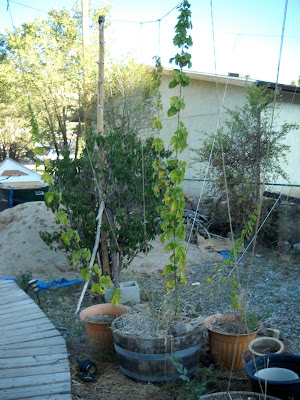
2010's Chinook Hops (3" tall)
On April 2nd the first of the Chinook hops emerged from their cold, soggy wine barrel home. Planted two years ago, the Chinook (think IPA brews) variety shares half of the barrel with a rhizome of the Centennial (think Pilsner) variety, and both have proved to be one of the most eager and vigorous perennials I've ever planted. I'll supplement the warming thermal mass of rocks ringing the barrel with a blanket on nights that drop below 25; I've also used christmas lights in years past to protect the early emerging shoots. When the chance of frigid cold nights passes, I'll cut all but 2 or 3 of the strongest vines (then about 1-2' long), and encourage them to start climbing the 10' string trellis. Throughout June and July I've seen the vines grow more than 2 inches a day! In more northern climates with longer summer day lengths, hops grow to more than 20' tall. In August they start to set flowers at the top of the vine, and I've usually harvested in early September.
The hop barrel's new growth
Originally, I bought five varieties of hops from Victor's Grape Arbor in Albuquerque (Victor orders hop rhizomes of various varieties for sale each April; $4 each) with the intention of experimenting with which variety would excel in our growing climate. Poorly planned transplants killed off 3 of the varieties the first year, and the Chinook variety has always been the strongest of the remaining two. However, I can't really attribute it's good health to being better adapted to this region, as the Chinook rhizome was also the biggest (and already sprouting) one I bought that year. It's first season it grew over 8' tall and produced a harvest of flowers that filled a gallon zip-lock bag.

2009's slightly disappointing vines
As the price of hops increases every year (there was a world-wide shortage in 2008), I've intended to plant a permanent row of hops (the constantly growing rhizomes much prefer to be in the ground, than trapped in a barrel), but another season seems to have come without me committing another portion of the garden to this vining perennial.

After the initial fermentation, hops stick to the top of the carboy







No comments:
Post a Comment